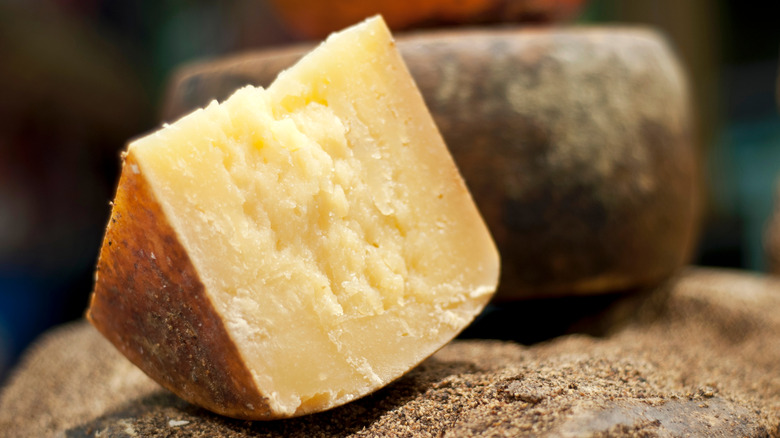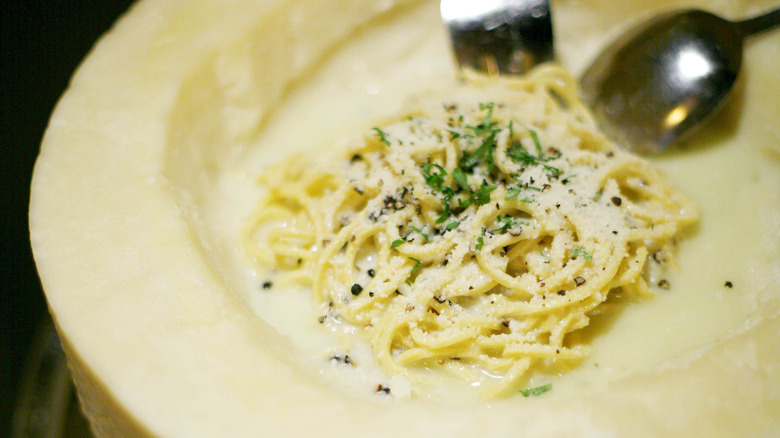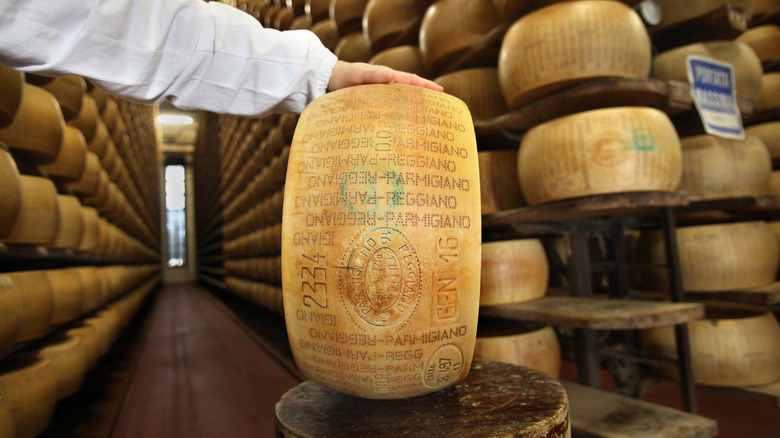Pecorino Romano Vs Parmesan: Can They Be Used Interchangeably?
In America, the default hard cheese that's sprinkled over pasta and salads is probably parmesan. However, there's a whole universe of sharp, savory, hard Italian cheeses can add a special something to countless dishes. One of the most popular, aside from parmesan, is Pecorino Romano, which is also referred to as Locatelli, the Italian brand that frequently distributes this cheese in the United States.
Parmesan — called Parmigiano Reggiano when produced in Italy following certain authenticity standards — is a cow's milk cheese that is aged for at least a year and often longer, while Pecorino Romano is a sheep's milk cheese and is aged for a shorter period of time, usually between eight months and one year. The resulting cheeses have a similar texture and appearance, but parmesan will have a sweet, nutty taste with a strong umami backbone, while Pecorino Romano will be saltier and have a zesty, tangy, and grassy flavor profile.
How to use parmesan and Pecorino Romano
Can you use parmesan and Pecorino Romano interchangeably? For the most part, yes. Both can serve a similar function in, for example, chicken parmesan (traditionally made with, obviously, parmesan) or a cacio e pepe (traditionally made with Pecorino Romano). However, each cheese will impart a slightly different flavor, and you will have to adjust your recipe to accommodate these differences. Since Pecorino Romano is much saltier than parmesan, you'll need to use more or less salt depending on the substitution. You'll also want to mind salty ingredients like anchovies, and perhaps dial those back as well, if you use Pecorino in place of parmesan.
Pecorino Romano works better in dishes with strong flavors that might overpower parmesan, such as tomato-based dishes or gratins with several other types of cheese. Pecorino is also worth tracking down to make a classic basil pesto. Both cheeses are great for topping vegetable dishes, pastas, salads, and pizza, and both have thick rinds that can be added to soup to make a rich vegetarian stock, so in these cases, use whichever cheese you prefer or have on hand.
Shopping for parmesan and Pecorino Romano
One of the advantages of buying Pecorino Romano is that, most of the time, you know that you're buying authentic stuff. This cheese has PDO status, meaning it must be produced in a certain location (in this case, Sardinia, Italy) under certain practices to legally bear its name. Any product labeled Pecorino Romano is almost guaranteed to be the real deal. Just be careful that you aren't buying Romano, which is an unrelated cheese made from cow's milk.
Parmigiano Reggiano, on the other hand, has a bit of a copycat problem. Much of the cheese sold in the United States as "parmesan" or a similar name is not true Parmigiano. If you want to find out if your parmesan is authentic, check the rind on the whole wheel of cheese before buying a slice or hunk. A special Parmigiano Reggiano seal should be stamped into the exterior rind.
If planning on serving Parmigiano Reggiano and Pecorino Romano on a cheese board to be eaten straight, pay attention to the age of the cheese. The texture of Pecorino Romano depends on its age, and will be softer and creamier when young, better for cheese plate territory than a hard, crumbly version. Parmesan, on the other hand, benefits from longer aging if you plan to eat it straight, as this makes its flavors more assertive.



